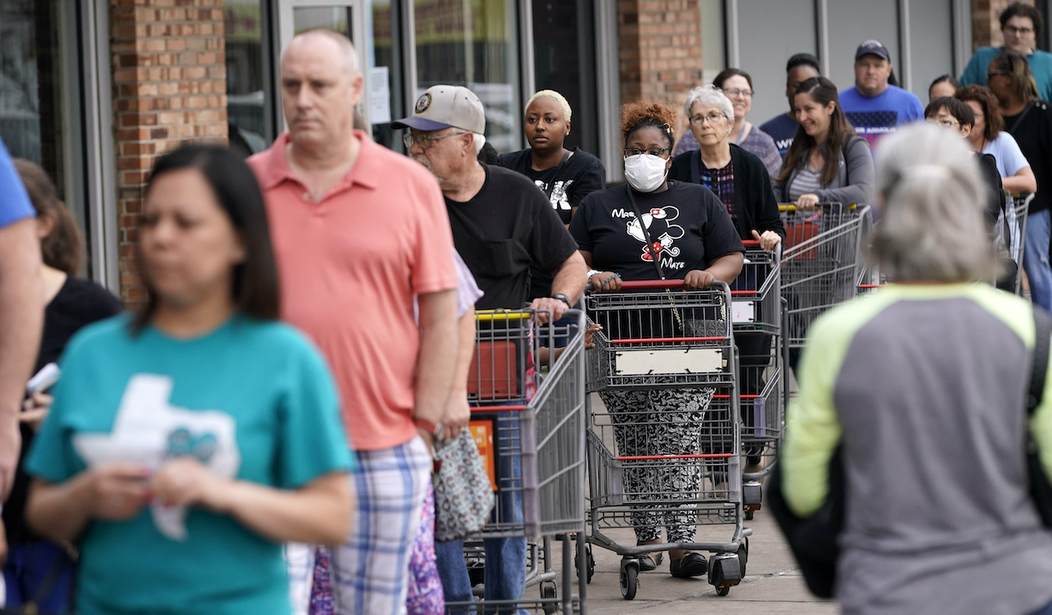$1,000,000,000,000
Do I have your attention now? When Steve Mnuchin began rattling off all kinds of ways the administration was considering getting money into Main Street, the market rejoiced by surging higher.
- $500 billion General Stimulus
- $200 billion Small Business Loans
- $250 billion Direct Checks to Main Street
- $50 billion Airline Bailout
Elected officials are negotiating with the White House about the size of direct checks that President Trump wants to go out “immediately.”
Ideas range from $1,000 per person to $2,000 for married couples, to recurring monthly and quarterly checks. This isn’t a universal basic income (UBI). It’s given that idea because it’s a shot in the arm as well as so many other maneuvers that will go into effect during the crisis. I have a feeling the one trillion-dollar price tag will get larger.
Market’s Cautious Cheers
The stock market continued its turbulence but exhibited spunk after several upside spurts were derailed. There were times it looked as if the market was going to collapse before finally seducing some sideline money off the sidelines.
The session was still overly cautious with Utilities erupting higher, although cloud and chip names welcomed buyers back with open arms and higher share prices.
S&P 500 Index | +6.00% |
Communication Services (XLC) | +4.34% |
Consumer Discretionary (XLY) | +3.85% |
Consumer Staples (XLP) | +8.43% |
Energy (XLE) | +0.68% |
Financials (XLF) | +5.43% |
Health Care (XLV) | +6.28% |
Industrials (XLI) | +4.61% |
Materials (XLB) | +6.19% |
Real Estate (XLRE) | +6.07% |
Technology (XLK) | +6.81% |
Utilities (XLU) | +12.79% |
Still, it felt like you could throw darts and hit a winner yesterday (as long as they weren’t oil producers). The market breadth was narrower than what a 1,000-point rally on the Dow would suggest.
Recommended
NYSE & NASDAQ
- Advancers: 4,033
- Decliners: 2,342
- New highs: 20
- New lows: 2,430
- Up volume: 8.7 billion
- Down volume: 4.3 billion
Private Profits Socialized Misery
The American public never fully got over the fact that Wall Street’s fat cats had to be bailed out after they enjoyed years of largess fueled by unbridled greed. People were looking for folks to go to jail; instead, taxpayer funds made sure private jet fuel never missed a payment.
Steven Mnuchin knows all about this, as a banker back in those days, which is why he furiously defends the notion any money handed over to the airline industry and Boeing (BA) is not a “bailout.”
The same airliners that hiked bag fees after the attacks that took down the World Trade Center in New York - they have blueprints to eventually have passengers stand and hold onto straphangers like subway commuters. Now, they want to get a $50.0 billion injection of cash. That number dwarfs their $15.0 billion 9-11 bailout. That number would be a whole lot lower if the airlines still had the billions spent on buying back their stock.
"This is apparently how the company has decided to use some of the $8.7 billion in tax breaks the state of Washington granted them, and that's shocking.” A spokesman for Society of Professional Engineering Employees in Aerospace Puget Sound Business Journal Dec 17, 2014 |
Then there’s Boeing, which had made a mess of things, even before the global coronavirus crisis. The company took down its entire $13.8 billion credit facility yesterday and has made it known it will need big-time cash from the federal government.
This opens the door for criticism of the company, which focused more on rewarding shareholders than research and development. Prescience Engineers commented about this in an article in the Puget Sound Business Journal in 2014. However, for Boeing’s management, it was all about letting the good times roll until the 737 debacles.
Let the Good Times Roll
Beginning in 2013, Boeing went on a spree to return maximum dollars to its shareholders. Between 2013 and the first quarter of 2019, the company bought back $43 billion in stock, while investing only $15.7 billion into commercial jet research & developments.
Authorized buybacks and dividends:
- 2013 buyback: $10 billion dividend $0.73 from $0.50
- 2014 buyback: $12 billion dividend $0.91 from $0.73
- 2015 buyback: $14 billion dividend $1.09 from $0.91
- 2016 buyback: $14 billion dividend $1.42 from $1.09
- 2017 buyback: $18 billion dividend $1.71 from $1.42
- 2018 buyback: $20 billion dividend $2.06 from $1.71

Portfolio Approach
I know you’re ready, and we have spent the last couple of days talking to subscribers about having cash on hand.

The Fed’s Bottomless Quiver
Yesterday, a friend wrote to me to say the Fed has run out of ammo, and I chuckled because the Fed will never run out of ammo - a point that should have been made clear going back to 1961 and affirmed during the Great Recession.
I saw all these Fed moves coming and wrote about them on March 2, 2020, Payne’s Perspective. Here is an excerpt from my perspective and may refresh your memory.
What’s Next
? Let’s Twist, Again
Midway through Friday’s session, Federal Reserve Chairman Jerome Powell held an impromptu news conference to announce:
"The fundamentals of the U.S. economy remain strong; however, the coronavirus poses evolving risks to economic activity."
"The Federal Reserve is closely monitoring developments and their implications for the economic outlook. We will use our tools and act as appropriate to support the economy."
The press conference clears the way for the Fed to take emergency action before the March meeting without spooking the market.
Although a Fed rate cut would more than likely be greeted with cheers instead of jeers, speculation has run rampant. The Fed would step in at 1,000 points, losing sessions mounted during the week.
Getting the Fed in the Dancing Mood
The Federal Reserve was established to lend to banks; however, during the panic of the Great Depression in 1932, Congress expanded its lending authority.
The first big emergency measure was known as “Operation Twist,” in part because the goal was to twist and flatten the yield curve by selling short-term bonds and buying long-term bonds. At the time, “The Twist” song and dance craze were still going strong after Chubby Checker scored big with his recording of the song, which hit number one in September 1960 (the song reemerged again in 1962, hitting number one in September of that year).
Economic historians are torn over whether the action had any real impact, but the tactic was implemented again in June 2012, resulting in the 10-year Treasury yield, hitting a 200-year low.
Since then, the Fed has tried:
- “Saturday Night Special”
- “Quantitative Easing, I (QE)”
- “Quantitative Easing II (QE)”
- “Quantitative Easing III(QE)”
- “Zero Interest Rate Policy”
The Fed’s Magic Toolbox
The Fed has a long history of big programs to stem emergencies and shift public behavior. However, in recent years, it’s been the smaller programs that have stretched the imagination, making the debate about limited arrows in their quiver a moot point.
During the financial crisis, the Fed went through a checklist of reactions, including reducing the discount rate to 5.75% from 6.25% or 0.5%, above the Fed’s funds target at the time. That wasn’t enough, so the Fed got creative:
- Term Auction Facility (TAF) in December 2007
At the height of the program, there was $493 billion in outstanding TAF credit
- Term Securities Lending Facility (TSLF) in March 2009
At the height of the program, there were $236 billion in TSLF loans outstanding.
- Primary Dealer Credit Facility (PDCF) in March 2008
At the height of the program, $130 billion in credit extended through the PDCF was outstanding on September 29, 2008
- Asset-Backed Commercial Paper Money Market Mutual Fund Liquidity Facility (AMLF) on Sept 08
At its peak, there was $152 billion in AMLF loans outstanding
- Commercial Paper Funding Facility (CPFF) in October 2008
At its peak, the CPFF had $350 billion of loans outstanding
- Term Asset-Backed Securities Loan Facility (TALF) in June 2010
The TALF peaked at $48 billion
Now the Street is looking for the Federal Reserve to step up with action before their scheduled March Federal Open Market Committee (FOMC) gathering.
A 25-basis point cut should be the start. Already, Goldman Sachs (GS) is telling clients to expect three rate cuts by June.
Keep in mind that the Fed has intervened in the Repo market since last September, a move that was going to be a one-off, which continues to this day. When the Fed suggested tapering off the market, it moved lower.
Yes, the stock market is over-reliant on the Fed, which I wish wasn’t true. Now, Jay Powell & Co will have to placate Wall Street to stem Main Street’s angst, so the wealth effect can keep those animal spirits aloft against the backdrop of media hysteria.
Today’s Session
The markets will open significantly lower, but you already knew that as the pattern continues. The message is clear that the market is still looking for more. The administration will have to go bigger to stem the short term but painful economic impact from shutting down the nation and the world.
Let’s see if S&P 500 2,367 holds. At some point, we’ll get that reversal session that signals selling exhaustion. Right now, headlines continue to conspire against oversold conditions and stimulus efforts.
Juggernaut Stalled
It becomes more moot each day, but it is very important to remember the strength in the economy in January and February in part because it could stave off negative first quarter GDP print, and it’s something we can work to resume over the summer into 2021.
Housing starts -1.5% beat consensus of -4.3%, but the data was even better than the headline would imply. Like the retail sales report yesterday, the prior month’s strong upward revision must be recognized. In this case, January starts pace were 1.624 million up from 1.567 million initial read.

























Join the conversation as a VIP Member